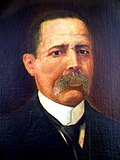| | |||||||||||||||||
| |||||||||||||||||
Presidential election | |||||||||||||||||
| |||||||||||||||||
| |||||||||||||||||
General elections were held in Costa Rica in 1889. [1] Electors for the electoral college were elected on 7 October 1889, who in turn elected the president on 1 December 1889. Despite initially rejecting the opposition's victory, mass demonstrations on November 7 ultimately forced the government to accept the results; November 7 continues to be celebrated in Costa Rica as "Democracy's Day." [2] For the first time in Costa Rica's history, political parties took part in the election. [3]
Contents
Liberals had enjoyed political hegemony in Costa Rica since independence. Unlike other Latin American countries were conflicts and alternation between liberals and conservatives was common, all Costa Rican presidents since the first, Juan Mora Fernández, were liberals with only one exception; Vicente Herrera Zeledón who, despite been conservative, was still a puppet of liberal dictator Tomás Guardia. [3] A series of alliances between the liberal intellectual elite, the coffee-grower bourgeoisie and the army maintained a status quo known as the Liberal State.
Throughout this period, the state's relationship with the Catholic Church was normally cordial. It wasn't until the presidency of the liberal freemason Bernardo Soto Alfaro that the most secularizing and anti-Catholic policies were taken, straining the relationship between the two. [3]
The Church responded by endorsing its own candidate: lawyer José Joaquín Rodríguez Zeledón of the Democratic Constitutional Party. The liberals, including Soto's government, endorsed Ascensión Esquivel Ibarra from the "Olympus" group, a group of intellectual aristocrats nicknamed as such because of their elitism. Soto went even as far as to allow Esquivel to run the presidency for a while. The Constitutional Party identify itself by using the National pavilion, whilst the Liberal Progressive Party used a red flag, the traditional color of the liberals in Latin America. [4] During the campaign Rodríguez was accused of trying to impose a religious government (despite the fact that he publicly endorsed the need for church-state separation) [5] whilst Esquivel was signaled for Freemason, liberal and Nicaraguan. [5]
The election at the time was held in two levels; first all the male citizens were allowed to vote for second-degree electors, then the electors selected the President from among the candidates. [4] The first round of vote was public; the second was secret. The requirements to be an Elector generally included having properties and knowing how to read, which meant that most of them belonged to the rich families or the middle class. [4] Rodríguez won the popular vote but Soto proclaimed Esquivel the winner and a military parade in support of Esquivel was held on November 7. [5] The Church made a call to defend the results on the streets on November 7 and Soto, fearful of a civil war, resigned and his successor Carlos Durán Cartín handles the power to Rodríguez. [3] [4]

